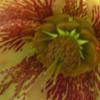
Galanthus nivalis Sandersii Group
When I tell people that I am going to look at snowdrops they often look at me quizzically -” surely a snowdrop is a snowdrop is a snowdrop” they say. “What’s the fuss, they are just pretty small white flowers?” And so it may seem until you start to look beyond the blanket of the big garden retail chains and seek out the specialist nurseries and horticultural groups and then you start to notice, come the winter, that there is a small club within the club who are all obsessed with snowdrops. They can be seen huddled around a single specimen in a pot discussing its virtues, or lack of, who bred it, its ancestry and you quickly realize that there is a whole hidden world out there – the world of the galanthophile.
I only started to understand the fascination a few years ago when I visited a galanthophile’s garden and saw the different varieties growing alongside each other. It dawns on you that this variety is much taller than that, or some have glaucous leaves, some strappy leaves, some double flowers, some with longer petals than others but the important thing, I think, is that you have to see them growing in a garden setting in clumps to be able to start to see the differences.

Sir Henry Elwes at Colesbourne Gardens
Today I was fortunate enough to have a tour of Colesbourne Gardens in Gloucestershire, the home of Sir Henry and Lady Elwes. Colebourne has been described in Country Life as ‘England’s greatest snowdrop garden’. Why is this so when you only have to look in any Sunday supplement or gardening magazine at this time of year to see lists of ‘snowdrop gardens’? Well, apparently it is one of very few, if any, open to the public where you can not only see drifts of the species snowdrops but also sizeable clumps of the more choice varieties planted in a garden setting. Most snowdrop gardens have the drifts of naturalised snowdrops and some of the specialist gardens have pots of choice snowdrops on display but rarely are the two combined and few take the risk of labelling all their snowdrops including the rare varieties, for fear of theft.

Sir Henry and Lady Elwes’s attitude is that the garden is a private personal garden which they like to share with the public at this time of year. Sir Henry’s great-grandfather, Henry James Elwes, was a renowned plant collector and collected the original Galanthus elwesii in Turkey in 1874. He was a leading light in the galanthophile world of his time and just as now there was much sharing and swapping of plants leading to significant collections being established including at Colesbourne. Sadly, after his death, his plant collections did not fare too well and were either dispersed or disappeared. Since inheriting the property Sir Henry and Lady Elwes have worked hard to re-establish the snowdrop collection with the garden opening for the first time in 1997. Establishing such a display is not for the faint hearted or work shy. Few snowdrops produce seed, so to create the stunning drifts you see you need to lift and divide and replant the clumps on an annual basis.

In 2003 the couple embarked on a major restoration project with the assistance of the then Garden Manager, Dr John Grimshaw, to restore the gardens and to celebrate the work of their illustrious ancestor. The work has led to the snowdrop collections being enlarged and added to on a yearly basis with some 5000-6000 bulbs planted up each year for sale. The Elwes, along with their current Head Gardener, Chris Horsfall, believe in selling the plants growing in pots so you know you will not only get a plant from a reputable source but one that is growing well. But it isn’t all about the snowdrops, the couple believe strongly in supporting local charities, and over the last 10 years £70,000 has been raised from catering for visitors and donated to charity.

At Colesbourne the snowdrops are planted out in the woodland but as you get nearer the house the plantings start to become more formal with a Woodland and Spring garden and then a much more formal garden by the house where the choicest snowdrops live. I particularly liked the way that the snowdrops in the garden settings were planted amongst plants with good foliage which set off the snowdrops such as cyclamen, corydalis, heuchera, ferns and epimediums. It showed you that a winter garden really doesn’t have to look dull at all and with a little clever planning the border does not have to be an exclusively winter one if you remember to plant the snowdrops where they won’t be disturbed such as in the shadow of deciduous ferns, bergenias and stacys.

Having established a reputation for Colesbourne as one of the must see snowdrop gardens, Sir Henry is now working towards achieving a similar reputation for the garden’s arboretum. His great-grandfather collected many choice trees during his travels and these, along with the snowdrops, still remained when the couple inherited the property. The style of the arboretum is more naturalistic than say Westonbirt, it is more of a landscape and plantsman’s garden and given the pedigree of some of its specimens it is hardly surprising to discover there are 8 champion trees. This year, from May, the garden will be opening for arboretum tours.

Colesbourne Gardens is open to the public on Saturdays and Sundays from 1pm from the 31st January 2015 to 1st March 2015 – details of how to find the garden can be found on their web-site along with details of the study days they are also running.

